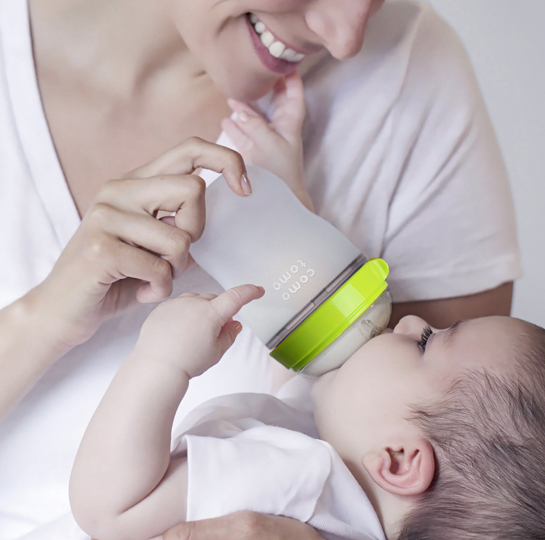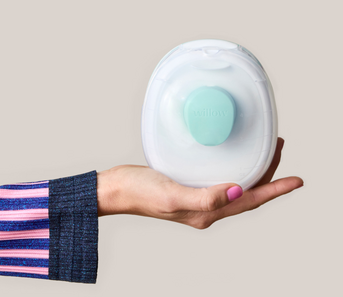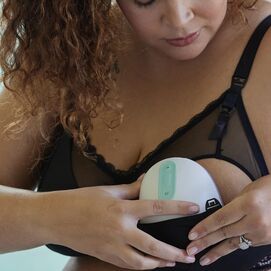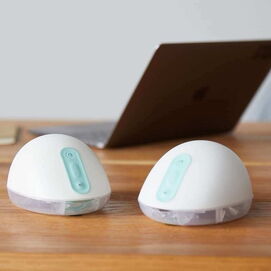Feeding your new baby is a big responsibility. According to Stanford Children’s Health, your baby grows more in the first year of life than any other time, which means it’s especially important to ensure your little one is getting all the nutrients they need. Queue the stress panic of — “am I doing this right?!” (You’re doing a great job, mama!)
With the amount of feedings, planning, and food options out there, it’s understandable if you’re feeling overwhelmed about baby feeding. We’re here for you. One thing that can help reduce that stress or worry? A feeding schedule. Just like you have those classic baby milestones, you can have a similar guide set out for feedings that will help your baby start good eating habits right from the get-go.
In this post, we’ll cover the first year of feeding schedules for your newborn, what they should be eating when, and some of the most common questions about baby feeding.
When Should My Baby Start a Feeding Schedule?
While there are a lot of should’s in baby development and baby care, keep in mind, a lot of these should’s can be a little flexible — every baby is different and your little angel is equally as unique. Which also means there’s no perfect time for when your baby should start a feeding schedule..
In the beginning, your baby’s needs are going to be inconsistent and it’s important to simply feed on demand, meaning whenever your newborn’s hungry, it’s time for a feed. Over time, feedings will become more regular and that’s when you can start to think about feeding schedules. There’s no perfect time frame, but many experts say you can start getting a more regular feeding schedule together between 2 to 4 months.
Breast Milk vs. Formula Schedules
While every baby will be a little different, generally, breastfed babies will need slightly more frequent feedings than bottle fed babies. Why? Because babies can digest breast milk quicker than formula, meaning they can refill sooner. When breastfeeding, they also may eat less at each feed than formula feeding, so they’ll need more frequent feeds.
One other difference between formula and breast milk is when coming directly from the breast, it’s much more challenging to measure exactly how much your baby’s actually eaten. With that in mind, it’s even more important to pay attention to your baby’s signals for when they’re hungry or full.
Newborn Feeding Schedules
In the first few months of your baby’s life, it may feel like schedules and routines are a thing of the past — all that’s left is exhaustion and diapers. Hang tight mama, this won’t last forever.
For the moment, the feeding schedule is going to be loose. Exactly how loose depends on the type of feeding you’re doing (breast feeding, exclusive pumping, or formula), how you personally function as a human, and what your baby needs.
One thing is certain for your baby at this point in life: they are not on solid foods. Feed your newborn breastmilk or formula. Those are your two options. Introducing other foods will come in time.
Sample Newborn Feeding Schedule (0-3 months)
|
Age |
Sessions per day (Breastmilk) |
Time Per Session |
Sample Time Schedule |
|
0-2 months |
8-12 or every 2-3 hours |
~15 minutes |
7 am |
|
2-3 months |
6-8 feedings or every 3-4 hours |
~15-20 minutes |
7 am |
Our Favorite Bottles
Our Favorite Bottles
You want only the best bottle for your pumped milk. For breastfed babies, we love Comotomo bottles.
3-5 Month Feeding Schedules
As your baby gets older, they’re getting bigger too, which means that little tummy’s getting bigger too! So that once, marble-sized tummy is quite a bit bigger now and can hold more milk at one time. That’s good news for you, because it means those feedings can become less frequent.
If you’re breastfeeding, expect to be nursing around 6 to 8 times a day. Your little one might be nursing a bit longer at each feeding and might be a bit more efficient at getting that milk. At 3 months, it’s still 100% breastmilk so no solids yet!
If you’re feeding formula, you may have slightly fewer feedings — say around 5 to 7 times a day and having around 4 to 6 ounces per feeding.
If you’re feeling anxious to get on with solid foods and reduce feeding times, remember: your baby needs this time and that nutrients! Your little angel will never be this tiny again. Take time to appreciate this time you have with your baby and see each feeding as a bonding opportunity.
Stay attuned to your baby’s body language and how they’re developing. You can keep track of metrics like diaper changes and weight gain.
That being said, you can start to get in some minor changes to get your baby ready for those new foods. If things are going well with your baby moving into the 4 to 5 month range, you can try to start tuning the feeding schedule to your own regular eating times and have feedings around the table to get them used to eating in that area.
Check with your doctor first on this one, but some experts suggest that between 4 and 6 months, you can try 2 to 3 teaspoons of iron-fortified infant cereals or dry infant rice cereal mixed with some formula or breast milk.
| Age | Sessions per day (Breastmilk) | Time Per Session | Sample Time Schedule |
| 3-5 months | 6-8 or every 3-4 hours | ~15-20 minutes | 5 am 8 am 12 pm 3 pm 6 pm 9 pm 1 am |
6-12 Month Feeding Schedules
You’ve made it through 6 whole months with your little one! Can you believe how fast time flies? If you haven’t already, now’s the time you can start introducing your baby to the wonderful world of food! They’ll still be getting a large portion of their nutrients from breastmilk or formula though, so still be sure to keep that up as well. As your baby gets closer to the one year mark, you can start discussing weaning off breastmilk or formula and moving entirely to solid foods.
Introducing solids to your child’s diet is an important step in your baby’s development and you want to take it seriously (even if it is pretty funny and cute seeing the cereal mush smeared all over their face). Double check with your doctor to ensure your little one is absolutely ready for some solid foods.
With starting this new adventure into the food world, there are a few guidelines you want to keep in mind:
- Only introduce one new food at a time and give it 3 to 5 days before introducing another food. This will help you identify if your baby has any food allergies or intolerances because you’ll know that’s the only food change you’ve made.
- Start small. Like, teaspoon-sized small. Just give a teaspoon of that new food at first, then slowly build up to the recommended amount for that food.
- Don’t give your baby honey in any form before 12 months.
- There are some certain foods that are big no-nos for infants because of choking risk. Don’t give these foods to your little one: whole nuts, grapes, any hard food that isn’t chopped into tiny pieces, hot dogs, cheese cubes, peanut butter.
Your general timetable for introducing foods will depend on your child and how they react to the different foods. However, as long as you’re slowly introducing more options, you’re on the right track.
The right first food to give to your little one depends on which expert you ask, but many recommend iron-fortified infant cereals or dry infant rice cereal mixed with breastmilk or formula. You can then move into the realm of pureed vegetables and fruits. Eventually, around the 8-10 month mark (or getting the OK from your doctor), you can start to introduce baby meats and protein like lean chicken or fish, scrambled egg or egg yoke, mild cheeses, and yogurt.
Baby Feeding Schedules: FAQ's
When Can a Baby Go Longer Than 4 Hours Between Feedings?
This will often depend on your baby! Newborns and babies younger than 3 months should not go longer than 4 hours between feedings — wake them up if you have to. Past 3 to 4 months, you can often follow cues from your baby. Some will have longer, less frequent feedings, while other babies will have short and frequent feeds.
When Can You Stop Feeding a Baby at Night?
We don’t generally recommend trying to stop night feeds before your baby’s at least 6 months old. Beyond that, we can’t give you a hard and fast answer, sorry mama!
Your baby has her own agenda and plan. If you’re really struggling with them or if your baby’s moving into the 9, 10, or 11-month mark, you may consider talking to your doctor about how you can start that process of reducing night feeds.
Is it OK to Feed a Newborn on Demand?
Yes! In fact, most health professionals recommend this with newborns. As newborns, babies need as much nutrients as they can get, so whenever your baby is hungry, it’s time to feed!
How Do I Know if My Baby is Eating Enough?
This can be a little easier to gauge with bottle feeding, but if your baby seems to get satisfied after a feeding and is consistently gaining weight, they’re probably getting enough food. Another useful way you can measure whether your baby’s eating enough is daily diapers.
If your baby isn’t pooping regularly or they’re falling below an average growth chart, those may be signs that something’s not quite right (it could be eating, or it could be something else).
Willow 360™ Wearable Breast Pump
Willow 360™ Wearable Breast Pump
Willow 360 is designed with a zero-gravity latch to give you 360° of leak-proof mobility. It's the hands-free breast pump that changed the game.
Need Help With Your Breastfeeding Schedules? Consider Pumping.
Alright mama, we’ve gone through a whole lot of information here. Is your head ready to explode yet? Don’t stress — no matter what stage your baby is at right now, this post will be here if you ever need to recap feeding schedules or check the next age feeding schedule.
If you’re a working mom or are having trouble keeping up with breastfeeding schedules with your baby, you may want to consider breast pumping with the Willow Wearable Breast Pump. With this hands-free electric pump, you can get on with your day while you also get the breast milk you need for your baby. This can also help your partner take on some of the feeding responsibility and give them a chance to bond with the baby.















